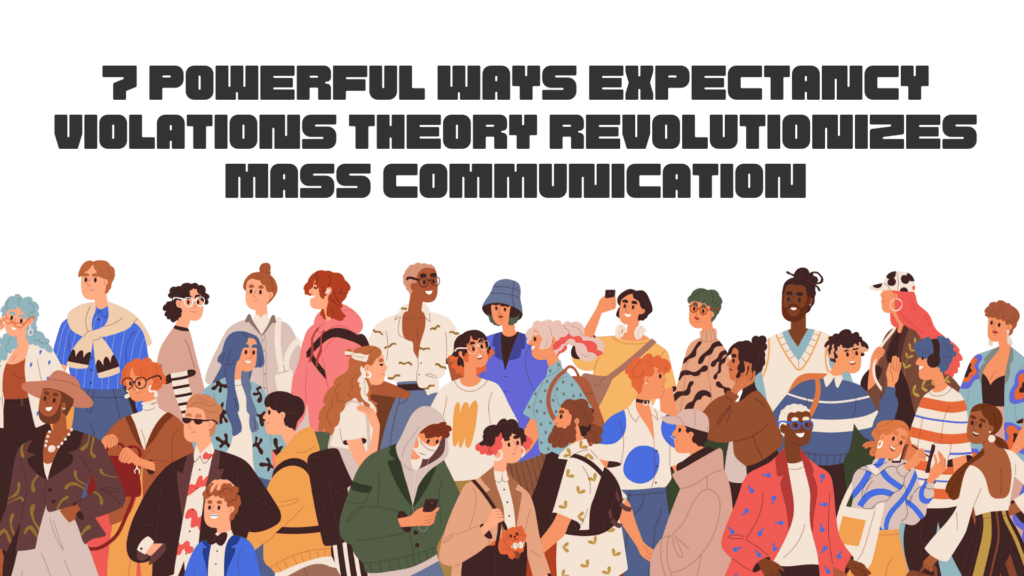What is Expectancy Violations Theory (EVT)
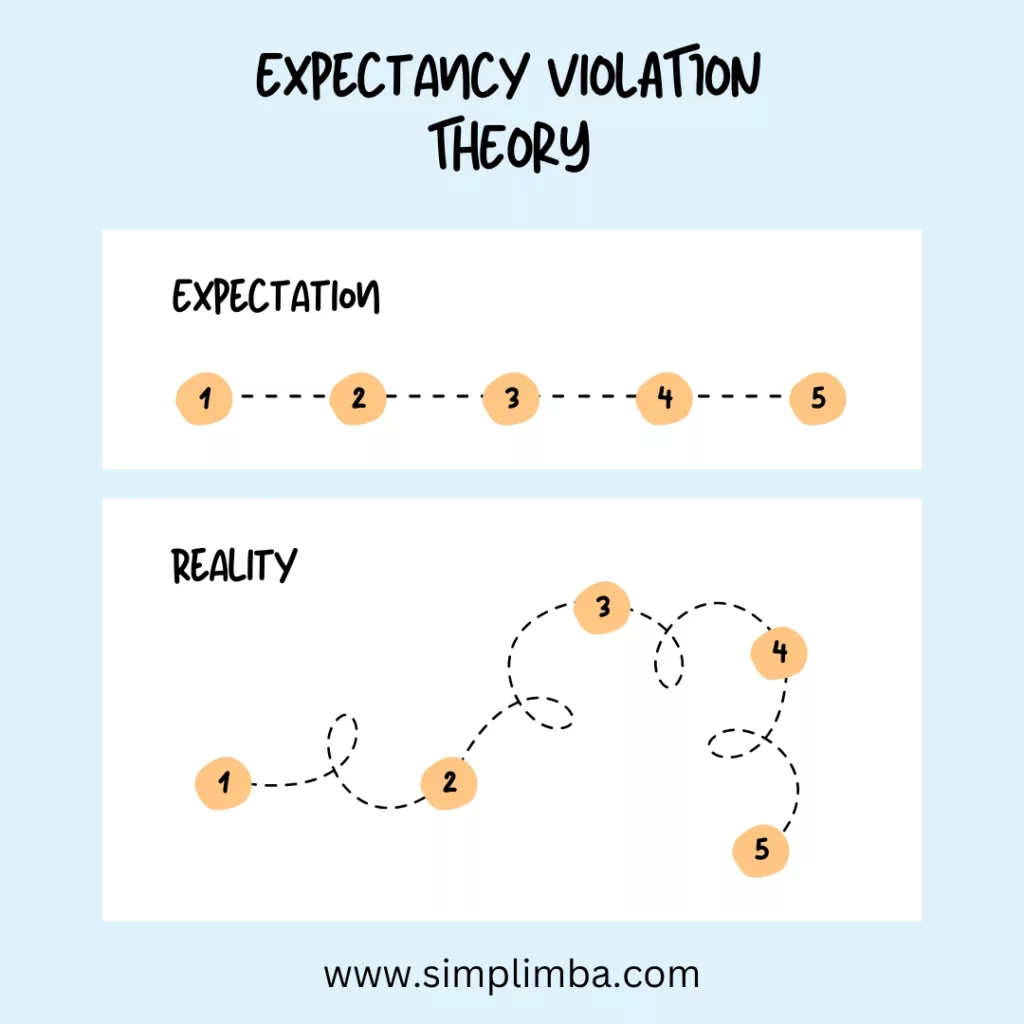
The Expectancy Violations Theory (EVT) is a communication theory which suggests that people have expectations about the behavior of others, and when these expectations are violated, the violation is perceived as either positive or negative depending on the liking between the people involved.
EVT consists of three main components: expectancy, violation valence, and communicator reward valence. Expectancy refers to what an individual anticipates will happen in a given situation, violation valence is the perceived positive or negative value assigned to a breach of expectations, and communicator reward valence assesses the possible benefits of the interaction.
For more theories of Mass communication like Expectancy Violations Theory, Read our comprehensive blog here
Key Components of Expentecy Violations Theory
According to this theory, people have expectations about behavior in given situations, and when these expectations are violated, the violation can be perceived as either positive or negative, depending on the perception of the violator.
Key components of the Expectancy Violations Theory include:
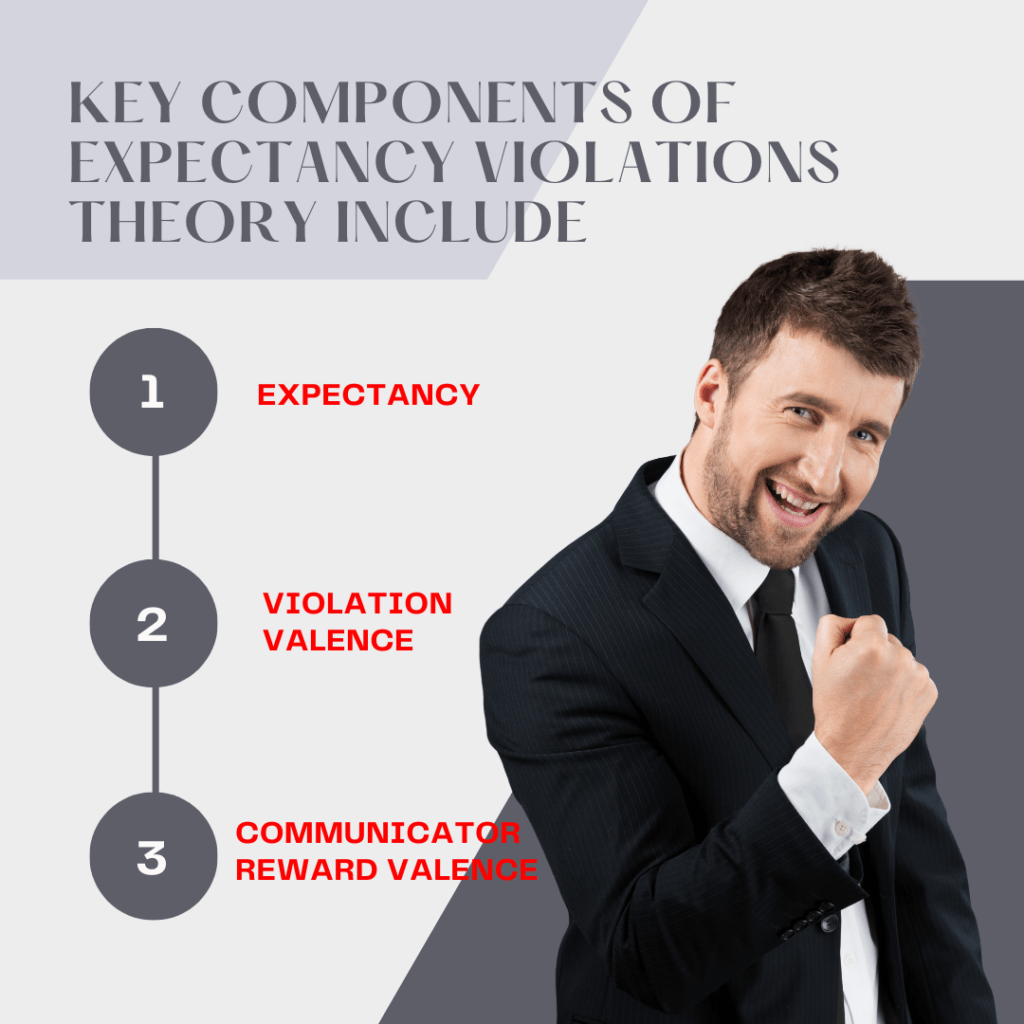
Expectancy: Expectancy is what people predict will happen, rather than what they desire. In communication, people have expectations about how others should behave based on social norms, interpersonal relationships, and individual characteristics. For example, in a professional setting, one might expect formal language and a certain level of respect.
Violation Valence: This refers to the perceived positive or negative value assigned to a breach of expectations, regardless of who the violator is. For instance, if a person is interrupted while speaking, the interruption could be perceived negatively (as rude) or positively (as a sign of active engagement), depending on the context and the individuals involved.
Communicator Reward Valence: This is the sum of positive and negative attributes brought to the encounter plus the potential to reward or punish in the future. In other words, how the recipient of the unexpected behavior perceives the violator can impact how the violation itself is perceived. For example, if the violator is a respected figure, their violations may be perceived more positively than if they were a disliked individual.
These components interact in complex ways to shape our responses to unexpected behaviors. According to EVT, when an expectancy violation occurs, we evaluate the violation in terms of violation valence and communicator reward valence. The combination of these evaluations then influences our response.
Read about 25 Theories of Mass Communication in our comprehensive post here
Expectancy Violations Theory Examples
Expectancy Violations Theory (EVT) is a communication theory that seeks to explain the reactions individuals have when their expectations about interpersonal communication are violated. Here are a few examples of EVT in action:
Personal Space Invasion): One of the most common examples of EVT is when someone invades your personal space. In most cultures, there’s an unspoken rule about how close you should stand to someone. When someone stands too close, it violates our expectations, and we react – usually by stepping back to reestablish our personal space.
The formula here would be: Expectation (personal space) + Violation (space invasion) = Reaction (step back).
Unexpected Behavior: Let’s say you’re at a formal event and someone starts behaving in a way that’s not in line with the event’s norms – for instance, they start dancing wildly when everyone else is standing around making polite conversation. This unexpected behavior violates your expectations, and your reaction could range from amusement to annoyance, depending on various factors such as your relationship with the person.
The formula here would be: Expectation (formal behavior) + Violation (wild dancing) = Reaction (amusement/annoyance).
Unexpected Communication: Imagine you receive a text message from your boss late at night. This violates your expectations because it’s outside of normal business hours, and your reaction might be surprise or concern, depending on the content of the message. The formula here would be: Expectation (no work-related communication outside business hours) + Violation (text from boss) = Reaction (surprise/concern).
In terms of consumer psychology and marketing, EVT can be used to grab attention and generate interest. For instance, a company might use an unexpected headline or image in an ad to violate consumers’ expectations and make them take notice. However, it’s important to note that violating expectations can also backfire if it’s not done correctly. If the violation is too extreme or off-putting, it could turn consumers off instead of drawing them in.
A study by Journal of Marketing Communications found that ads that moderately violated expectations were more effective than those that conformed to expectations or those that violated expectations too much. The researchers used a scale of 1-7 to measure the level of expectancy violation, with 1 being conformity and 7 being extreme violation. Ads that scored around 4-5 on this scale were found to be the most effective.
Therefore, while EVT can be a powerful tool in marketing and copywriting, it’s crucial to strike the right balance. Too little violation and you won’t grab attention; too much and you could alienate your audience.
Relevance of EVT in Mass Communication
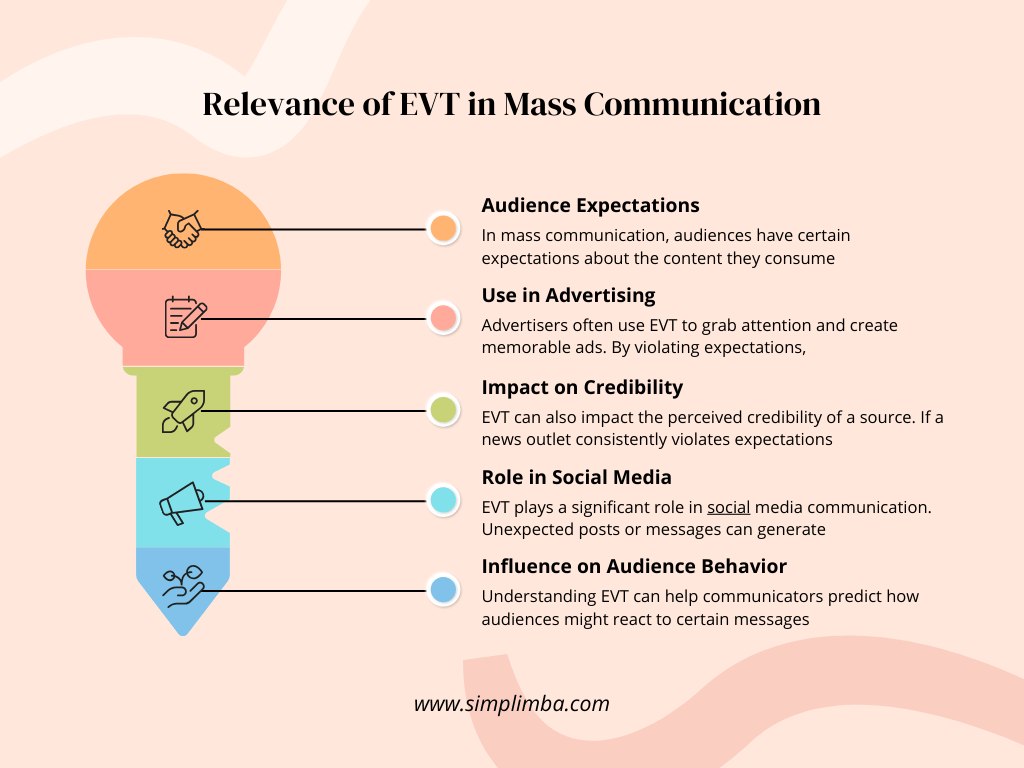
Audience Expectations: In mass communication, audiences have certain expectations about the content they consume. For instance, they expect news to be unbiased and informative. When these expectations are violated, it can lead to increased attention and engagement, or it can result in negative responses if the violation is perceived negatively.
Use in Advertising: Advertisers often use EVT to grab attention and create memorable ads. By violating expectations, they make their ads stand out from the crowd. For example, Old Spice’s “The Man Your Man Could Smell Like” campaign violated expectations with its surreal humor and rapid-fire dialogue, which helped it become a viral sensation.
Impact on Credibility: EVT can also impact the perceived credibility of a source. If a news outlet consistently violates expectations by presenting biased or inaccurate information, it can lose credibility with its audience. Conversely, if an outlet exceeds expectations by consistently providing high-quality, insightful content, it can increase its credibility.
Role in Social Media: EVT plays a significant role in social media communication. Unexpected posts or messages can generate significant attention and engagement. However, they can also backfire if they violate expectations in a negative way.
Influence on Audience Behavior: Understanding EVT can help communicators predict how audiences might react to certain messages. This can be particularly useful in areas like public relations and crisis communication, where managing audience reactions is crucial.
Origins and History of Expectancy Violations Theory
Origins of Expectancy Violations Theory: The Expectancy Violations Theory was first proposed by Judee K. Burgoon in the late 1970s. Burgoon, a renowned professor of Communication, Psychology, and Family Studies at the University of Arizona, developed this theory to understand the influence of non-verbal communication on message production. The theory emerged from her interest in studying proxemics, a subcategory of the study of nonverbal communication that deals with the amount of distance between individuals when they are interacting.
Development of the Theory: Over time, the Expectancy Violations Theory evolved to include verbal communication as well. It suggests that people have certain expectations about the behavior of others. When these expectations are violated, the violation can either be perceived positively or negatively, depending on the relationship and context. The theory further developed to include the concept of ‘violation valence’, the perceived positive or negative value assigned to a breach of expectations, and ‘communicator reward valence’, the sum of positive and negative attributes brought to the encounter plus the potential to reward or punish in the future.
Critiques and Revisions: Like any theory, Expectancy Violations Theory has faced critiques. Some scholars argue that the theory lacks clarity in defining what constitutes an expectancy, how they are formed, and what factors influence them. In response to these critiques, Burgoon has refined the theory over the years, providing more clarity on these aspects.
The Impact of Expectancy Violations Theory on Mass Communication
Expectancy Violations Theory (EVT) postulates that people have certain expectations for how others will behave in a given context. When these expectations are violated, the violation can either be perceived positively or negatively, depending on the relationship between the individuals and the nature of the violation.
Expectations: In the realm of mass communication, audiences have certain expectations for messages they receive. For instance, they expect news to be unbiased, advertisements to be persuasive, and entertainment to be engaging.
Violations: Violations occur when the message deviates from these expectations. For example, an advertisement that is overly aggressive can be perceived negatively, while a news report that provides a fresh perspective can be viewed positively.
Perception: The way audiences perceive these violations can significantly impact their response to the message. A positive violation can enhance engagement, increase message recall, and improve persuasion. On the other hand, a negative violation can lead to disinterest, misinterpretation, and even backlash.
Modifying Factors: Several factors can modify the impact of violations, including the relationship between the sender and receiver, the context of the message, and the audience’s personal and cultural norms.
Case studies demonstrating the influence of EVT in mass communication
Case Study 1:A classic example of EVT in mass communication is the “1984” Super Bowl commercial by Apple. The commercial deviated from the audience’s expectations by presenting a dystopian future, which was a stark contrast to the light-hearted, product-focused ads typically seen during the Super Bowl. This violation of expectations was perceived positively, leading to increased attention and interest in Apple’s Macintosh computer.
Case Study 2: Conversely, a negative example of EVT would be the Pepsi ad featuring Kendall Jenner in 2017. The ad was criticized for trivializing important social issues, violating audience expectations for sensitivity and respect towards such matters. This resulted in a negative backlash and the ad was eventually pulled from broadcast.
7 Powerful Ways EVT Revolutionizes Mass Communication
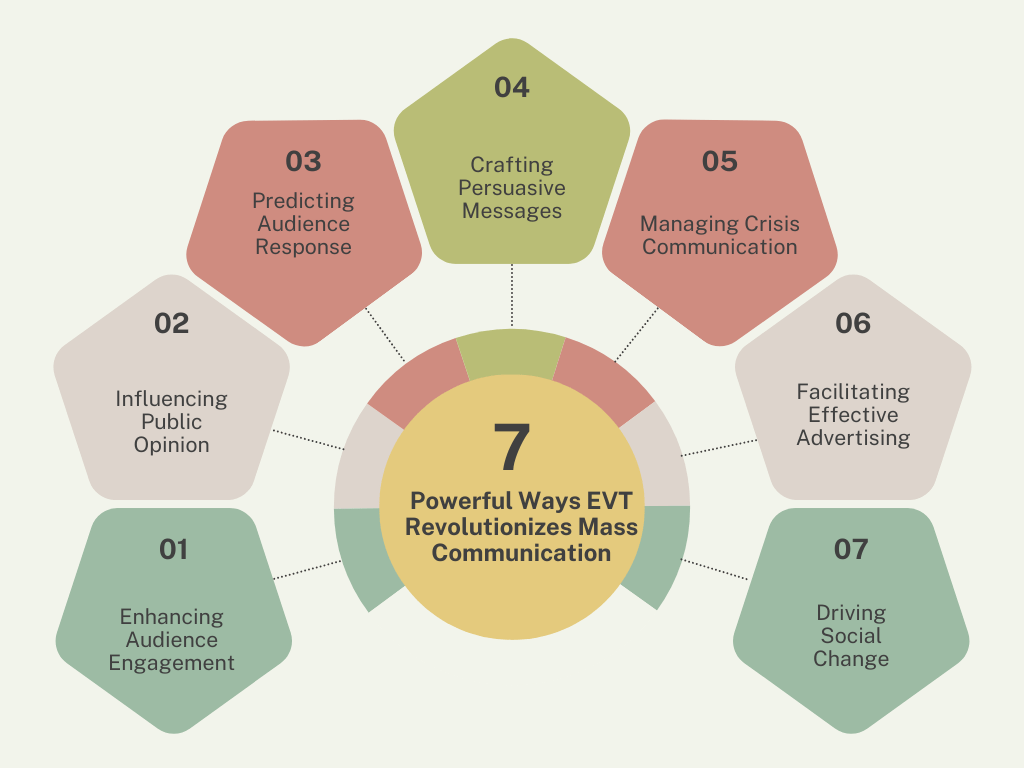
Enhancing Audience Engagement
EVT, or Expectancy Violation Theory, can significantly enhance audience engagement by creating unexpected or surprising content. This theory is based on the premise that people have expectations about how others should behave, and any violation of these expectations can lead to increased attention and interest. Thus, by creating content that violates the audience’s expectations in a positive way, you can capture their attention and keep them engaged.
For instance, using an unexpected headline or lead can instantly grab the audience’s attention, piquing their interest and making them want to read more. This can be achieved by using the AIDA formula – Attention, Interest, Desire, Action. Firstly, grab their attention with a surprising headline. Then, keep their interest by providing fascinating information or insights. Next, create a desire by showing how your product or service can benefit them. Finally, encourage action with a strong, persuasive call to action.
Influencing Public Opinion
EVT can also be used to influence public opinion by challenging existing beliefs or expectations. By presenting information or perspectives that contradict common beliefs, you can make people reconsider their views and possibly change their opinion. This can be particularly effective in marketing campaigns or social change initiatives.
Predicting Audience Response
Understanding EVT can help predict how the audience might respond to a particular message. If a message greatly violates their expectations, they might react negatively. However, if the violation is positive and provides them with value or entertainment, they might react positively. This understanding can guide in crafting messages that resonate with the audience and elicit the desired response.
Crafting Persuasive Messages
EVT can be used to craft persuasive messages by violating expectations in a way that benefits the audience. For example, if you’re selling a product, you could violate the expectation that your product is expensive by offering it at a surprisingly low price. This unexpected benefit can make your message more persuasive and increase the likelihood of a purchase.
Managing Crisis Communication
In a crisis, people often expect companies to be defensive or evasive. By violating these expectations and being transparent, accountable, and proactive, companies can manage crisis communication more effectively. This can help maintain trust and credibility among the audience.
Facilitating Effective Advertising
Advertisers can use EVT to create ads that stand out and capture attention. By presenting unexpected scenarios, using surprising visuals, or making bold claims, advertisers can violate audience expectations and make their ads more memorable and effective.
Driving Social Change
Finally, EVT can be used to drive social change by challenging societal norms or expectations. By presenting new ideas or perspectives that violate existing beliefs, you can encourage people to think differently and possibly change their behavior. This can be particularly effective in campaigns aimed at promoting social justice, environmental sustainability, or other important causes.
Samrat is a Delhi-based MBA from the Indian Institute of Management. He is a Strategy, AI, and Marketing Enthusiast and passionately writes about core and emerging topics in Management studies. Reach out to his LinkedIn for a discussion or follow his Quora Page

